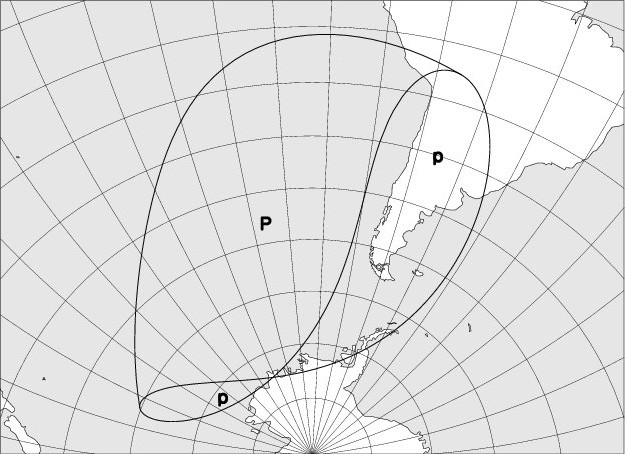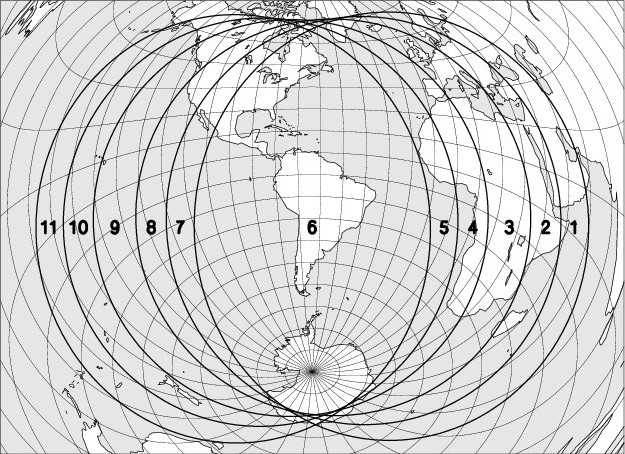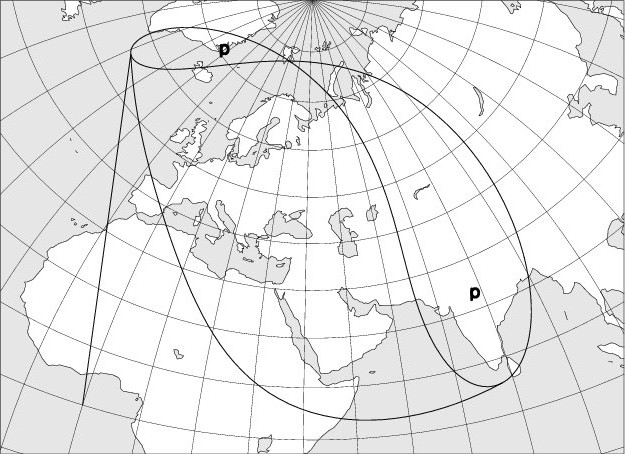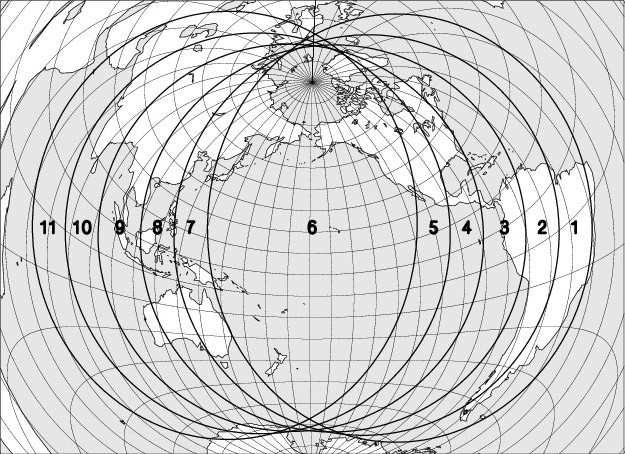In 2022, there will be four eclipses: two solar eclipses and two lunar eclipses
| Date | Type | Visibility |
| 30 April 2022 | Partial solar eclipse | Not visible in Belgium |
| 16 May 2022 | Total lunar eclipse | Partially visible in Belgium |
| 25 October 2022 | Partial solar eclipse | Visible in Belgium as a partial eclipse |
| 8 November 2022 | Total lunar eclipse | Not visible in Belgium |
I – 30 April 2022 – Partial solar eclipse, not visible in Belgium
| Phase | Universal Time | Longitude | Latitude |
| Eclipse begins | 18h45.3 | 151 10 W | 68 12 S |
| Maximum of the eclipse | 20h41.7 | 071 37 W | 62 05 S |
| Eclipse ends | 22h38.0 | 077 07 W | 25 07 S |
Magnitude of the eclipse: 0.640, the diameter of the solar disk being taken as the unit.
The map below shows the region where the eclipse is observable. The explanation of the codes used can be found at the bottom of the page.

II – 16 May 2022 – Total lunar eclipse, partially visible in Belgium
| Phase | Universal Time | Longitude | Latitude | Position angle |
Altitude at Uccle/Ukkel |
| Penumbral eclipse begins | 01h30.7 | 025 13 W | 18 47 S | 100 | +10 |
| Partial lunar eclipse begins | 02h27.6 | 038 53 W | 18 58 S | 95 | +10 |
| Total lunar eclipse begins | 03h28.7 | 053 35 W | 19 11 S | 78 | +3 |
| Moonset at Uccle/Ukkel | 03h48.8 | 058 24 W | 19 15 S | 60 | 0 |
| Maximum of the eclipse | 04h11.5 | 063 52 W | v | 19 | – |
| Total lunar eclipse ends | 04h54.3 | 074 10 W | 19 28 S | 321 | – |
| Partial lunar eclipse ends | 05h55.5 | 088 52 W | 19 41 S | 304 | – |
| Penumbral eclipse ends | 06h52.3 | 102 31 W | 19 52 S | 299 | – |
The longitude and the latitude refer to the point on Earth where the Moon is at that time at its zenith. The position angle is defined from the imaginary line that connects the center of the lunar disc to the center of the Earth’s shadow. It is measured at the center of the lunar disc, from the North, in an anti-clockwise direction. At the beginning and at the end of the penumbra and shadow phases, it is the position angle of the contact point. The altitude and times of the Moon’s rise and fall are calculated for its center, without taking refraction into account.
Magnitude of the eclipse: 1.419, the diameter of the solar disk being taken as the unit.
The map below shows the region where the eclipse is observable. The explanation of the codes used can be found at the bottom of the page.

III – 25 October 2022 – Partial solar eclipse, visible in Belgium as a partial eclipse
| Phase | Universal Time | Longitude | Latitude |
| Eclipse begins | 08h58.3 | 019 35 W | 66 34 N |
| Maximum of the eclipse | 11h00.4 | 076 59 E | 61 33 N |
| Eclipse ends | 13h02.3 | 066 48 E | 17 36 N |
Magnitude of the eclipse: 0.862, the diameter of the solar disk being taken as the unit.
The map below shows the region where the eclipse is observable. The explanation of the codes used can be found at the bottom of the page.

Phases in Uccle/Ukkel – Brussels (Observatory)
| Phase | Universal Time | Position angle relative to the pole | Position angle relative to the zenith | Altitude at Uccle/Ukkel |
| First contact | 09h09min34s | 350 | 13 | +21 |
| Maximum of the eclipse | 10h04min21s | 37 | 51 | +25 |
| Last contact | 11h00min52s | 82 | 87 | +27 |
Magnitude of the eclipse: 0.301, the diameter of the solar disk being taken as the unit.
The position angle relative to the pole, resp. the zenith, is the angle formed by the direction of the centre of the lunar disc with the direction of the pole, resp. the zenith. Both angles are measured at the centre of the solar disc in an anti-clockwise direction. At the beginning and at the end of the eclipse, they correspond to the position angles of the contact points.
The altitude of the Sun is that of a reference point, which is located during the eclipse in the eclipsed part of the Sun, and which coincides with the times of contact with the point of contact of the Sun and Moon. Refraction is not taken into account.
Visibility in Belgium
The table below gives the phases for some representative Belgian sites.
In Brussels and Wallonia:
| Location | Begin in universal time | Maximum in universal time | End in universal time | Magnitude |
| Brussels | 09h09min30s | 10h04min19s | 11h00min53s | 0.302 |
| Nivelles/Nijvel | 09h09min50s | 10h04min23s | 11h00min41s | 0.298 |
| Jodoigne/Geldenaken | 09h09min42s | 10h04min57s | 11h01min57s | 0.306 |
| Tournai/Doornik | 09h09min48s | 10h03min20s | 10h58min35s | 0.286 |
| Mons/Bergen | 09h10min02s | 10h04min02s | 10h59min45s | 0.290 |
| Charleroi | 09h10min06s | 10h04min37s | 11h00min51s | 0.296 |
| Chimay | 09h10min37s | 10h04min37s | 11h00min21s | 0.288 |
| Philippeville | 09h10min25s | 10h04min49s | 11h00min58s | 0.293 |
| Namur/Namen | 09h10min03s | 10h05min04s | 11h01min48s | 0.302 |
| Dinant | 09h10min20s | 10h05min13s | 11h01min49s | 0.299 |
| Gedinne | 09h10min44s | 10h05min23s | 11h01min44s | 0.295 |
| Huy/Hoei | 09h10min00s | 10h05min29s | 11h02min41s | 0.308 |
| Liège/Luik | 09h09min51s | 10h05min48s | 11h03min28s | 0.314 |
| Werbomont | 09h10min13s | 10h06min04s | 11h03min37s | 0.311 |
| Eupen | 09h09min55s | 10h06min20s | 11h04min29s | 0.319 |
| Saint Vith/Sankt Vith | 09h10min23s | 10h06min37s | 11h04min34s | 0.315 |
| Marche-en-Famenne | 09h10min24s | 10h05min44s | 11h02min47s | 0.304 |
| Bastogne/Bastenaken | 09h10min44s | 10h06min17s | 11h03min33s | 0.305 |
| Libramont | 09h10min51s | 10h05min56s | 11h02min43s | 0.299 |
| Bouillon | 09h11min00 | 10h05min37s | 11h01min57s | 0.293 |
| Virton | 09h11min21s | 10h06min17s | 11h02min55s | 0.295 |
| Arlon/Aarlen | 09h11min12s | 10h06min33s | 11h03min36s | 0.301 |
In Flanders:
| Location | Begin in universal time | Maximum in universal time | End in universal time | Magnitude |
| Veurne | 09h09min09s | 10h02min20s | 10h57min16s | 0.285 |
| Ostende/Oostende | 09h08min57s | 10h02min33s | 10h57min54s | 0.291 |
| Bruges/Brugge | 09h08min58s | 10h02min55s | 10h58min36s | 0.294 |
| Poperinge | 09h09min27s | 10h02min29s | 10h57min15s | 0.282 |
| Courtrai/Kortrijk | 09h09min30s | 10h03min06s | 10h58min27s | 0.288 |
| Gand/Gent | 09h09min12s | 10h03min32s | 10h59min37s | 0.298 |
| Audenarde/Oudenaarde | 09h09min29s | 10h03min28s | 10h59min13s | 0.293 |
| Grammont/Geraardsbergen | 09h09min35s | 10h03min50s | 10h59min49s | 0.295 |
| Alost/Aalst | 09h09min21s | 10h03min56s | 11h00min14s | 0.300 |
| Saint-Nicolas/Sint-Niklaas | 09h09min04s | 10h03min57s | 11h00min35s | 0.305 |
| Malines/Mechelen | 09h09min16s | 10h04min23s | 11h01min15s | 0.307 |
| Anvers/Antwerpen | 09h09min00s | 10h04min13s | 11h01min11s | 0.309 |
| Essen | 09h08min42s | 10h04min11s | 11h01min26s | 0.314 |
| Turnhout | 09h08min55s | 10h04min48s | 11h02min25s | 0.317 |
| Geel | 09h09min08s | 10h04min55s | 11h02min26s | 0.315 |
| Neerpelt | 09h09min05s | 10h05min23s | 11h03min25s | 0.322 |
| Hasselt | 09h09min27s | 10h05min24s | 11h03min05s | 0.316 |
| Tongres/Tongeren | 09h09min40s | 10h05min37s | 11h03min18s | 0.315 |
| Maaseik | 09h09min17s | 10h05min51s | 11h04min09s | 0.324 |
| Louvain/Leuven | 09h09min28s | 10h04min42s | 11h01min40s | 0.307 |
| Diest | 09h09min22s | 10h05min03s | 11h02min29s | 0.313 |
IV – 8 November 2022 – Total lunar eclipse, not visible in Belgium
| Phase | Universal Time | Longitude | Latitude | Position angle | Altitude at Uccle/Ukkel |
| Penumbral eclipse begins | 08h00.6 | 125 44 W | 16 15 N | 77 | – |
| Partial eclipse begins | 09h08.9 | 142 16 W | 16 29 N | 82 | – |
| Total eclipse begins | 10h16.3 | 158 35 W | 16 42 N | 102 | – |
| Maximum of the eclipse | 10h59.2 | 168 57 W | 16 51 N | 157 | – |
| Total eclipse ends | 11h42.0 | 179 20 W | 17 00 N | 213 | – |
| Partial eclipse ends | 12h49.4 | 164 22 E | 17 13 N | 233 | |
| Penumbral eclipse ends | 13h57.8 | 147 48 E | 17 27 N | 238 | – |
The longitude and the latitude refer to the point on Earth where the Moon is at that time at its zenith. The position angle is defined from the imaginary line that connects the center of the lunar disc to the center of the Earth’s shadow. It is measured at the center of the lunar disc, from the North, in an anti-clockwise direction. At the beginning and at the end of the penumbra and shadow phases, it is the position angle of the contact point. The altitude and times of the Moon’s rise and fall are calculated for its center, without taking refraction into account.
Magnitude of the eclipse: 1.364, the diameter of the solar disk being taken as the unit.
The map below shows the region where the eclipse is observable. The explanation of the codes used can be found at the bottom of the page.

Explanations:
The codes used on the maps to indicate the moon eclipse visibility are: entry into the darkness is visible in regions 1 to 6, entry into the darkness in regions 2 to 7, the beginning of the totality in regions 3 to 8. The exits of the totality, the shadow and the penumbra are respectively observable in regions 4 to 9, 5 to 10, and 6 to 11. In region 6, the entire eclipse can be observed, in regions 5 to 7 the umbral phases are observable; in regions 4 to 8 the totality is fully visible.
On solar eclipse visibility maps, the following codes are used:
“P”: Partial eclipse of the Sun, visible.
“p”: Partial eclipse of the Sun, partly visible.
“R”: Annular eclipse, whose annular phase is fully observable.
“r”: Annular eclipse, whose annular phase is partially observable.
“T”: Total eclipse, whose totality phase is fully observable.
“t”: Total eclipse, whose totality phase is partially observable.
The basic data used to write the eclipse chapter were borrowed from the DE405 digital integration, kindly provided by the Jet Propulsion Laboratory. To move from Terrestrial Time (TT) to Universal Time (UT), the following provisional relationship was used:
UT = TT – 69.0 s
